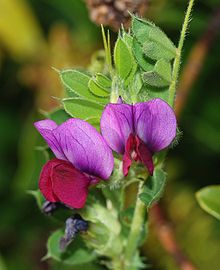- Vicia sativa
-
- "Vicia heterophylla" redirects here, based on the plant described by Carl Presl. The plant thus named by V.N. Voroshilov is Vicia japonica as described by Asa Gray.
Common Vetch 
Vicia sativa flowers and leaves Scientific classification Kingdom: Plantae (unranked): Angiosperms (unranked): Eudicots (unranked): Rosids Order: Fabales Family: Fabaceae Subfamily: Faboideae Tribe: Vicieae Genus: Vicia Species: V. sativa Binomial name Vicia sativa
L.Synonyms Vicia angustifolia L.
Vicia angustifolia Reichard
Vicia cordata Hoppe
Vicia cuneata Gren. & Godr.
Vicia cuneata Guss.
Vicia heterophylla C.Presl
Vicia segetalis Thuill.Vicia sativa, known as the Common Vetch, Tare or simply "the vetch", is a nitrogen fixing leguminous plant. Although considered a weed when found growing in a cultivated grainfield, this hardy plant is often grown as green manure or livestock fodder. There is no firm evidence that this is the same as the "tare" in some English translations of the Bible – ryegrass (Lolium) is another candidate.
There are at least four subspecies generally accepted:
- Vicia sativa ssp. cordata (Hoppe) Asch. & Graebn.
- Vicia sativa ssp. nigra (L.) Ehrh. – Narrow-leaved Vetch (= ssp./var. angustifolia, ssp. consobrina, ssp. cordata (Hoppe) Batt., ssp. cuneata, ssp. heterophylla, var. minor, var. nigra)
- Vicia sativa ssp. sativa (= var. linearis, ssp. notata)
- Vicia sativa ssp. segetalis (Thuill.) Arcang. (sometimes included in ssp. nigra)
Contents
Description
This is an annual herb with hollow, four-sided, hairless to hairy stems which can reach two meters in maximum length. The leaves are each made up of a few pairs of linear, lance-shaped, oblong, or wedge-shaped, needle-tipped leaflets up to 3.5 centimeters long. The pealike flowers occur in the leaf axils, solitary or in clusters of up to three. The flower corolla is 1 to 3 centimeters in length and whitish to bluish to red or bright pink-purple in color. The fruit is a legume pod up to 6 or 7 centimeters long which is hairy when new and smooth later. It contains up to 12 seeds.
Cultivation
When intended as fodder, the seed is sown densely, up to 250 kilograms per hectare. However, when grown for seed, less seed should be used; otherwise the crop will be too thick, reducing flower and seed production. When meant for seed, sowing is done early in the planting season for good returns; but, when for green food, any time in spring is suitable. Sometimes, a full crop can be obtained even when sown as late as summer, though sowing so late is not recommended.
After the seed is sown and the land carefully harrowed, a light roller ought to be drawn across, to smooth the surface and permit the scythe to work without interruption. Also, the field should be watched for several days to prevent pigeons, which are remarkably fond of tares, from devouring much of the sown seed.
Horses thrive very well on Common Vetch, even better than on clover and rye grass; the same applies to fattening cattle, which feed faster on vetch than on most grasses or other edible plants. Danger often arises from livestock eating too much vetch, especially when podded; colics and other stomach disorders are apt to be produced by the excessive loads devoured.
Cereal grains can be sown with vetch so it can use their stronger stems for support, attaching via tendrils.[1] When grown with oats or other grasses, the vetch can grow upright; otherwise its weak stems may sprawl along the ground.[2] Several cultivars are available for agricultural use,[3] and as for some other legume crops, rhizobia can be added to the seed.[2]
Pests that attack this crop include the powdery mildew fungus Erysiphe pisi, the pea aphid Acyrthosiphon pisum, the corn earworm (Heliothis zea), the fall armyworm (Spodoptera frugiperda), and spider mites of genus Tetranychus.[2]
History
Common Vetch has also been part of the human diet, as attested by carbonised remains found at early Neolithic sites in Syria, Turkey, Bulgaria, Hungary and Slovakia. It has also been reported from predynastic sites of ancient Egypt, and several Bronze Age sites in Turkmenia and Slovakia. However, definite evidence for later vetch cultivation is available only for Roman times.[4]
Notes
- ^ FAO Animal Feed Resources
- ^ a b c FAO Crop Profile
- ^ Lloveras, J., et al. Varieties of vetch (Vicia sativa L.) for forage and grain production in Mediterranean areas.
- ^ Daniel Zohary and Maria Hopf, Domestication of plants in the Old World, third edition (Oxford: University Press, 2000), p. 119.
External links
Categories:- Vicia
- Flora of Europe
- Flora of Estonia
- Flora of the United Kingdom
- Nitrogen-fixing crops
Wikimedia Foundation. 2010.
